Barbados: A Walk through History (Part 7)
Section 5 Sugar, Rum, and Slaves
(The historical records and literature provided in this column contain expressions which are now considered racist and inappropriate. They by no means reflect the opinion of the author, but rather are used to show the social situation of the time period being discussed.)
One of the things that came to grow on me while living in Barbados was rum.
However, it is quite unfortunate that while one can find a wide variety of liquors in Japan, rum’s popularity has not caught on. On the contrary, oftentimes whenever rum is brought up I get an insolent response such as “oh yes, that sweet and sugary liquor used to bake cakes and such with”. If in fact, the rum that you drink straight up is indeed sweet, then you have found yourself a “fake” rum!
“Authentic” rum made in Barbados and other Caribbean islands, which is exported around the world, is a high-alcohol content liquor made by fermenting, distilling, and aging molasses, which is a byproduct from the extraction process of sugar from sugarcane (note 1). However, this does not mean that the end product is by any means sweet. It possesses an aromatic nose and taste, making one think of a high-quality brandy, drunk straight, on the rocks, or up straight. Rum is also essential for the popular mojito and daiquiri cocktails. The chilled, fruity “Rum Punch” is also an essential to survive the heat of the Caribbean while getting slightly tipsy (however, drinking too much of a good-tasting rum punch will be cause for regret the next day).
The origin of rum is thought to have started around the second half of the 16th century with the start of sugar cane cultivation on the Caribbean islands. There are people who claim that Barbados was the first island to produce rum, but there are numerous other theories, making it impossible to discern the true origins. However, one thing that is certain is that the oldest rum distillery still in operation to this day is the Barbadian brand “Mount Gay Rum”, which started production from the beginning of the 18th century and continues into the present.
During my five and a half year stay in Barbados, I was very much indebted to rum. A few days before returning to Japan after my duties in Barbados ended in April 2022, Prime Minister Mia Mottley made the Mount Gay rum delivered to my doorstep with her message “I know this is your favorite”.
So, rum is an essential part of leisure and social life in the Carribean. But it unfortunately has a dark past.
A long time ago, when the main source of labor on sugar cane plantations was African slaves’ labor, rum was the result of their blood, sweat, and tears.
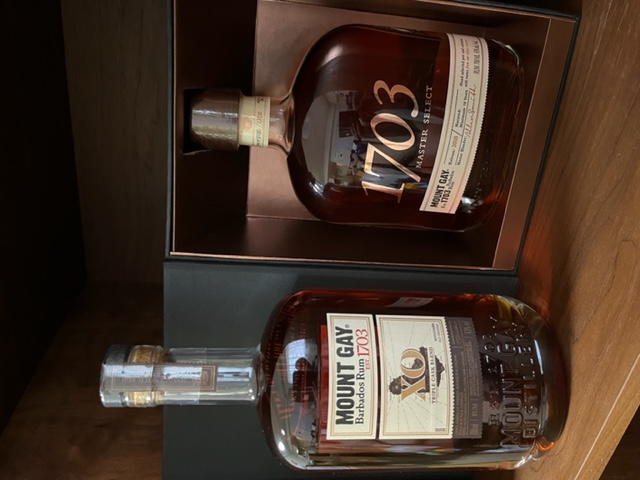
(The Barbados rum being made at the oldest rum distillery in the world)
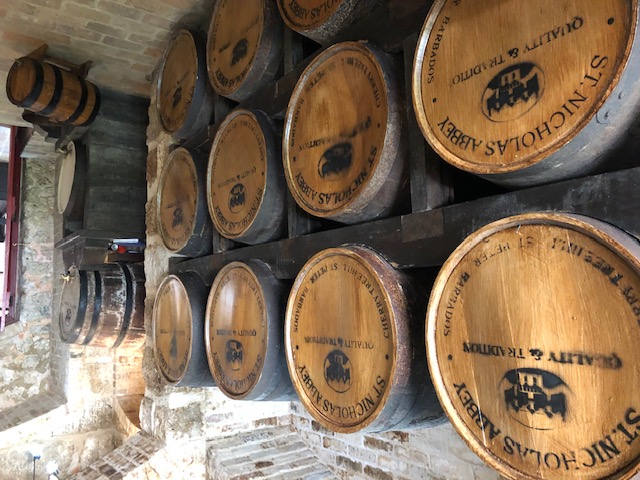
(High-quality rum is aged in barrels of oak or other material for a long time before drinking. Photographed at St. Nicholas Abbey)
The Concept of “Owning” People
“If any Negro or slave whatsoever shall offer any violence to any Christian by striking or the like, such Negro or slave shall for his and her first offense be severely whipped by the Constable. For his second offense of that nature he shall be severely whipped, his nose slit, and be burned in some part of his face with a hot iron. And being brutish slaves, deserve not, for the baseness of their condition, to be tried by the legal trial of twelve men of their peers, as the subjects of England are. And it is further enacted and ordained that if any Negro or other slave under punishment by his master unfortunately shall suffer in life or member, which seldom happens, no person whatsoever shall be liable to any fine therefore.” This is a part of the “Barbados Slave Code” enacted in 1661.
The preamble to the above passage claims that “they (slaves) are a heathenish, brutish, and uncertain dangerous kind of people”, and that this law is “to protect them as we do many other goods and chattels”. On the other hand, the Code stipulated that “all the slaves within this island shall have clothes once every year”; virtually the only thing they were able to own.
From a modern perspective this Code, the proper name of which is “An Act for Better Ordering and Governing of Negroes”(!), is utterly outrageous, but it was so written in the noble English of the 17th century. The words “heathenish, brutish…” are good examples of how the white English and Europeans viewed their Black slaves, whom they forcefully brought from Africa across the Atlantic for their own inhumane purposes.
The “Barbados Slave Code” is the first written law pertaining to the treatment of slaves in all of England’s colonies around the globe. This somehow became the “Model for Good Governance (?)”, and the rest of England’s colonies started following suit, with Jamaica, Antigua, South Carolina and others enacting similar laws.
Slavery and the Present
Slavery existed around the world in different forms, and Japan is not an exception. For example, the traditional Japanese Noh play “Sumida-gawa river” and novelist Ogai Mori’s tale “Sanshodayu (Sansho the Bailiff)” depict Japan’s version of the slavery and human trafficking.
However, when we hear the word “slave” in this day and age, our minds immediately produce images of the Atlantic Slave Trade-Africans dragged across the Atlantic Ocean to the colonies in the American continents and the West Indies. This form of trade was once related to a large-scale and systematic state undertaking of some European countries. And even now descendants of slaves who were brought to the former European colonies still face racism and a myriad of complex problems, which occasionally shake society and even the country as a whole.
In Barbados, the overwhelming majority of the population is Black, and the former white “upper class” have fallen to a small, reserved community making anti-Black racism all but non-existent. Nonetheless, just as any country’s history is reflected in its present, one cannot deny that the existence of slavery in the past influences current Barbados’ course and its people’s pattern of behaviors.
The Reality of the Atlantic Slave Trade
The Atlantic Slave Trade began in earnest in the 16th century, first by the Portuguese and then by the Spanish. They exported cheap European goods to the West Coast of the African continent, which is where they procured their Black slaves (note 2). The trade was started by “exporting” those African people to colonies in the West Indies and American continents, and brought back mineral resources and agricultural products from these destinations to Europe.
African slaves were used as the labor force working in the mines and on plantations in the colonies. Actually, before the arrival of Africans, the indigenous peoples (Native Americans) had been forced to work in the Portuguese or Spanish colonies, but their population dramatically reduced due to over-work, wretched environment, and diseases such as the influenza and smallpox brought over from the European continent. This is the primary reason why African slave labor took over that of the indigenous people.
The Portuguese and Spanish slowly lost their power over the Atlantic entering the 17th century, and as they retreated England, France, the Netherlands, and even Denmark and Sweden started to sully their hands in the slave trade.
The Atlantic Slave Trade lasted for over 300 years well into the 19th century. There is not an accurate number of how many Africans were forced into slavery during this period, but according to research after the trade ended, the number ranges from a couple of million to tens of millions.
I have at my hand a book of the name “Caribbean School Atlas”. It is used in classrooms in Barbados and other English-speaking countries in the Caribbean. It states that between the years 1500 and 1870, one million slaves were brought from the west coast of Africa to both North and Central America respectively, 3.5 million slaves to South America, and 4.5 slaves to the Caribbean. This is a total of ten million, and after pouring over other sources, this seems to be a reasonable number (note 3).
However, any of these numbers cannot be taken at face value. The voyage across the Atlantic from Africa took at least two to three months on a sailing vessel at the time. A large portion (some say around 20 to 30%) of Africans who were squeezed under the decks died due to the squalid conditions leading to disease and prostration, and their bodies were thrown overboard into the ocean. Thus, the number of Africans forced onto ships should be much larger than the number who survived the voyage and landed in the colonies.
If one considers that the target of such a large “trade” must have been mainly young healthy people, it is fair to say that Africa’s society and economy suffered indescribably over those 300-plus years. The devastation incurred has had a serious effect over Africa’s development even after the end of the slave trade.
This can be considered one of the worst acts of inhumanity against another race/people carried out in the history of Christian philanthropy-touting white Western civilization.
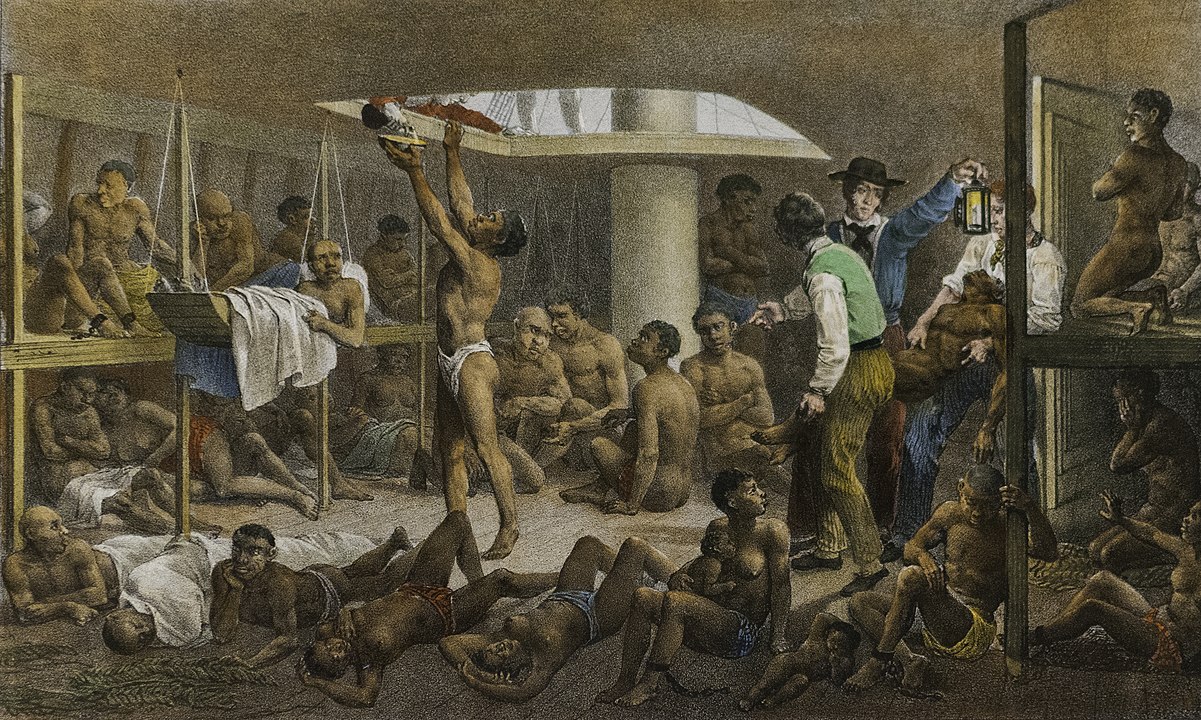
(Depiction of inside a slave ship)
African slaves were brought over systematically to Barbados starting around the middle of the 17th century.
As previously mentioned, when Barbados became under English colonial rule, white indentured servants first became the main source of manual labor. Barbados’ largest income then was from tobacco. In the beginning of their settlement, the English colonists grew tobacco plants at comparatively small farms using the indentured servants’ labor force and exported the products to Europe.
However, shortly after the island’s tobacco farms found themselves in a predicament-they were losing out to England’s North American colony Virginia’s tobacco industry. Virginia’s tobacco was of better quality than Barbados’, and after England realized this, it set the tariff rate on Virginia tobacco way below that of Barbados, making it difficult for Barbados to continue exporting.
The Netherlands extended a helping hand to Barbados at this time; the rising maritime nation supplied preserved foods, clothes, and other necessities at a low price, as well as lent money at low interest rates to tobacco farm owners.
The Dutch, seeing that the tobacco industry was going downhill in Barbados, introduced sugarcane farming to the island, which was popular in Brazil. The Dutch, after having seized the eastern region of Bahia from the Portuguese in 1624, built their settlement centered in Recife in 1630 and used African slave labor to work on the sugarcane plantations. The British and French were just starting to become full-fledged presences in the Caribbean, thus commercially-speaking the Dutch were one step ahead. It is said that the first person to bring sugarcane over to Barbados from Brazil in 1637 was the Dutchman Pieter Blower. The Dutch were skilled traders, going so far as to take Barbados’ tobacco plantation owners on “tours” of sugarcane plantations in Brazil to convince them to do business together.
Barbados’ climate and soil were perfect for sugarcane cultivation. In the beginning the cane itself was used for consumption, and the molasses that came from compressing the stem was used to make rum; however, sugar production for export began in the 1640s.
Around this time, the custom of drinking tea picked up from China and Japan, as well as the custom of drinking coffee from West Asia became popular in Europe. The Europeans had an affinity for adding sugar to their tea and coffee, along with sweet, sugary cakes. Without the Caribbean’s rich supply of sugar, the tea drinking and sweet indulging habit of Europeans would not have been born.
The sugar industry in Barbados was getting on truck for a short while, with the export of sugar and rum providing a hefty profit. The price of land increased dozens of times as owners rushed to annex off more land for sugarcane plantations. It might be easy to write off plantation owners as making an easy profit, but this is where a big problem came to light--a lack of labor force on the fields.
By that time, Indentured servants provided most of the manual labor, but their numbers were no longer sufficient enough to tend to all the fields. Once their term of service was over, they were free to leave, which put the plantation owners in a predicament in searching for permanent workers. Large-scale farming which was supported by the manual labor of indentured servants was not a sustainable way of farming.
Once again, the Dutch proposed another new project for Barbados. Maybe their proposition went something like this: “if you don’t have enough workers, why not just use Black slaves? We’ll cut you a good deal”. The Dutch were trying to find a good customer for their slave trade as they had taken over the slave trade bases on the African west coast from the Portuguese on the wane.
Barbados plantation owners pounced on this proposition; according to surviving historical documents kept in Barbados, in 1645 the Black slave population on the island was only slightly under 6,000, but in 1684 the number at increased to 60,000, three times the number of the white population. On the other hand, the number of indentured servants gradually decreased, with the number at only 2,000 (note 4).
The background to the introduction and establishment of the use of African slave labor in Barbados was the change from tobacco to sugarcane farming; in other words, there was a change in the industrial structure of the shift from idyllic medieval small-scale farming to more modern, early capitalist large-scale plantation farming.
Recipe for Sugar and Rum
What were the daily lives like of the African slaves working on the sugarcane plantations?
There was division of labor among slaves, but let’s take a look at the hardest job, field work.
——I wake up at dawn and leave my shabby hut which I call home. I head for the sugarcane fields by foot-this is the beginning of the day’s work. The other slaves and myself harvest the sugarcane, which towers over our heads; we take a ratchet and cut the leaves off the stem of the sugarcane. The cane is taken to be crushed with a heavy, manual stone compressor; it takes the strength of three to four of us to turn the stone press and squeeze the liquid out of the cane (note 5). The liquid produced is a sweet juice, which is temporarily stored in a barrel and later simmered in an iron pot. If the pot cools down the smooth liquid becomes glutinous, so it remains over open fire for 24 hours; the person on the late-night shift has to work in the scorching heat in the hut. When the concentrated juice is removed and cooled, crystalized drops of sugar appear. The dark, thick molasses that formed on the bottom of the pot during the sugar extraction process is scraped off and used to make rum by using yeast to ferment the molasses, and afterward distilled and aged.——
This is a simplified description of a day in the life. The slaves on plantations filled their hungry stomachs with corn porridge and bacon and carried on toiling in the fields day after day. Sugarcane leaves have sharp edge, making it very painful work; to add salt to the wound, the slaves were performing this painful work under the blistering Caribbean sun. In the days before rum production became a sophisticated process, it was a rough, cheap drink that acted as a potable version of smelling salts for slaves as they were overworked on the fields and became dizzy in the heat of the day.
The use of African slaves on the Caribbean sugarcane plantations were thought to be considerably crueler than that of their counterparts on North American cotton plantations. Later, Karl Marx argued that without slavery you have no cotton; without cotton you have no modern industry. It is slavery that has given the colonies their value; it is the colonies that have created world trade, and it is world trade that is the pre-condition of large-scale machine industry, pointing out that slavery was one of the significant factors pushing the British industrial revolution (note 6). However, although Marx had his attention turned to North American cotton plantations, his focus did not quite make it all the way to the Caribbean sugarcane plantations.
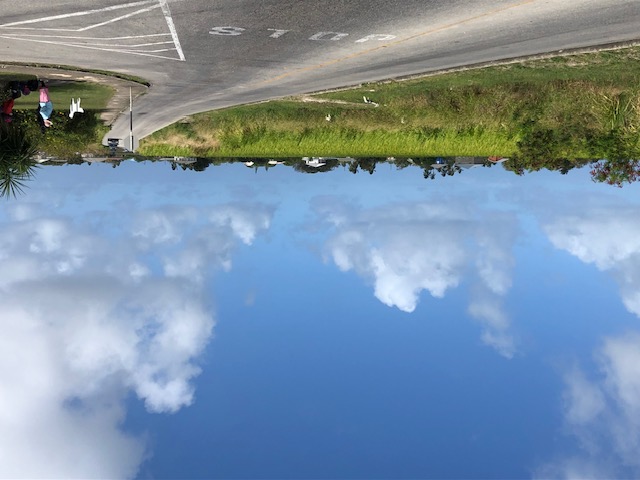
(Current sugarcane field (scenery from inland Barbados))
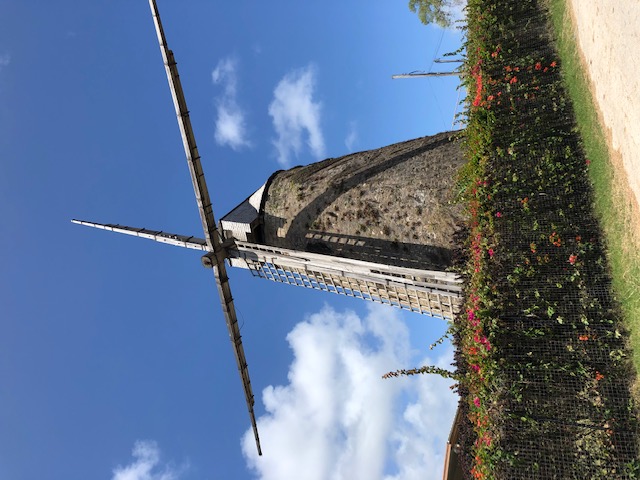
(Site of “Morgan Lewis Windmill”. This is the last windmill in Barbados remaining with sails)
It is obvious by looking at the “Barbados Slave Code” that there was no concept of slaves having any type of human rights. This extended to all forms of “employee benefits”, such as vacation days, labor streamlining, the upkeep of a sanitary environment, etc. It is easy to imagine that there was a high death rate even among young slaves, making that the overall lifespan of slaves quite short. Sugarcane plantation owners thought it more economical to bring more slaves over from Africa if labor started to dwindle rather than invest in creating a healthy, sustainable environment for the current slaves to live.
Throughout the 18th century, the yearly average number of slaves “imported” to Barbados was around 3,000. Children born to slaves were considered “products” to make money off of, and were often forced away from their parents and put up for auction. Plantations were ultimate “Exploitative companies” with a toxic environment beyond description (note 7).
While the export of sugar and rum made Barbados’ economy thrive, the inhumane use of African slave labor produced a dark side to its history. All of the historical figures introduced in previous columns (such as Baron Willoughby, Admiral Ayscue, and other stately men who played a major role in Barbados’ early colonial period; pirates Bartholomew Roberts, Blackbeard, as well as English kings and Oliver Cromwell, etc.) were beneficiaries of the slavery.
(To be continued)
(Note 1) Most rums have around 40 to 50% alcohol by volume. The liquid itself has variation: a gold rum which has brown color attained while being aged in oak barrels, and a white rum which is often carbon-filtered and immediately distilled. A gold rum tends to be of higher value.
(Note 2) The area that supplied the Atlantic Slave Trade are the current countries such as Guinea, Ghana, Ivory Coast, Nigeria, Cameroon, and Sierra Leone, etc. It is believed that most of the current population of Barbados share roots with people in the Ghana region.
(Note 3) It is assumed that the reason why such a large number of slaves were brought to the Caribbean, whose area is relatively small, is due to the fact that the lifespan of slaves in the Caribbean islands was short, and in addition to “replenishing” the number of slaves, Barbados and other Caribbean islands were a transit point for the shipments of slaves to North America and other regions.
(Note 4) The white indentured servant system ended in the 19th century. However, descendants of those indentured servants who were not able to climb the social ladder within the white community through the generations remained in Barbados, and to this day they live in a closed group of around 400 people. Derogatory terms for them such as “poor whites” and “red legs” (stemming from the observation that their white legs burn and turn red when exposed to the sun) are now considered incorrect and discriminatory. Being left behind from society, in addition to their poverty, unemployment, lack of enrollment in educational facilities, their life in a closed community results in incest, producing children with disabilities. These are all difficult problems to solve, and it is a dark side of Barbados’ society. Most of this poverty-stricken white community are descendants of Irish indentured servants, and thus in recent years the Irish government has begun to give aid to the community with no success to speak of as of yet.
(Note 5) The use of windmills to aid in the compression of sugarcane stems was imported from the Netherlands in the meantime. This is the reason why numbers of stone windmill towers are still standing in various locations around the island.
(Note 6) This remark is found in Marx’s letter dated December 28th 1846 to his Russian friend, Pavel Annenkov.
(Note 7) In the 1970s, the excavation of a cemetery of African slaves took place on the land of a former plantation in Christ Church Parish, located in the south of Barbados. The site was part of a plot of land dedicated to a slave village on the plantation established by settler Samuel Newton in the 1660s. Around 600 slaves of all ages and genders were buried here, and their daily goods and utensils have been found buried together. The site, called “Newton Slave Burial Ground”, is one of the largest slave burial grounds preserved in the Western Hemisphere.
(This column reflects the personal opinions of the author and not the opinions of the Ministry of Foreign Affairs of Japan)
WHAT'S NEW
- 2025.8.28 UPDATE
PROJECTS
"Barbados A Walk Through History Part 16"
- 2025.5.15 UPDATE
EVENTS
"417th Lecture Meeting Regarding Global Issues"
- 2025.4.17 UPDATE
EVENTS
"416th Lecture Meeting Regarding Global Issues"
- 2025.3.13 UPDATE
EVENTS
"415th Lecture Meeting Regarding Global Issues"
- 2025.2.20 UPDATE
EVENTS
"414th Lecture Meeting Regarding Global Issues"
- 2025.2.12 UPDATE
PROJECTS
"Barbados A Walk Through History Part 15"
- 2025.1.16 UPDATE
EVENTS
"413th Lecture Meeting Regarding Global Issues"
- 2024.12.19 UPDATE
EVENTS
"412th Lecture Meeting Regarding Global Issues"
- 2024.12.4 UPDATE
PROJECTS
"Barbados A Walk Through History Part 14"




